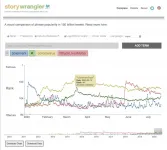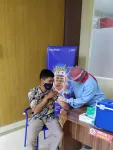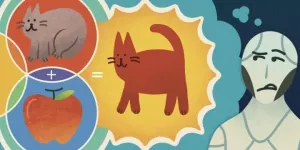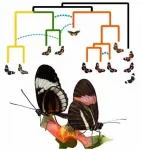(Press-News.org) UNIVERSITY PARK, Pa. -- From biochemical reactions that produce cancers, to the latest memes virally spreading across social media, simple actions can generate complex behaviors. For researchers trying to understand these emergent behaviors, however, the complexity can tax current computational methods.
Now, a team of researchers has developed a new algorithm that can serve as a more effective way to analyze models of biological systems, which in turn allows a new path to understanding the decision-making circuits that make up these systems. The researchers add that the algorithm will help scientists study how relatively simple actions lead to complex behaviors, such as cancer growth and voting patterns.
The modeling framework used consists of Boolean networks, which are a collection of nodes that are either on or off, said Jordan Rozum, doctoral candidate in physics at Penn State. For example, a Boolean network could be a network of interacting genes that are either turned on -- expressed -- or off in a cell.
"Boolean networks are a good way to capture the essence of a system," said Rozum. "It's interesting that these very rich behaviors can emerge out of just coupling little on and off switches together -- one switch is toggled and then it toggles another switch and that can lead to a big cascade of effects that then feeds back into the original switch. And we can get really interesting complex behaviors out of just the simple couplings."
"Boolean models describe how information propagates through the network," said Réka Albert, distinguished professor of physics and biology in the Penn State Eberly College of Science and an affiliate of the Institute for Computational and Data Sciences. Eventually, the on/off states of the nodes fall into repeating patterns, called attractors, which correspond to the stable long-term behaviors of the system, according to the researchers, who report their findings in the current issue of Science Advances.
Even though these systems are based on simple actions, the complexity can scale up dramatically as nodes are added to the system, especially in the case when events in the system are not synchronous. A typical Boolean network model of a biological process with a few dozen nodes, for example, has tens of billions of states, according to the researchers. In the case of a genome, these models can have thousands of nodes, resulting in more states than there are atoms in the observable universe.
The researchers use two transformations -- parity and time reversal -- to make the analysis of Boolean networks more efficient. The parity transformation offers a mirror image of the network, switching nodes that are on to off and vice versa, which helps identify which subnetworks have combinations of on and off values that can sustain themselves over time. Time reversal runs the dynamics of the network backward, probing which states can precede an initial input state.
The team tested their methods on a collection of synthetic Boolean networks called random Boolean networks, which have been used for than 50 years as a way to model how gene regulation determines the fate of a cell. The technique allowed the team to find the number of attractors in these networks for more than 16,000 genes, which, according to the researchers, are sizes larger than ever before analyzed in such detail.
According to the team, the technique could help medical researchers.
"For example, you might want a cancer cell to undergo apoptosis (programmed cell death), and so you want to be able to make the system pick the decisions that lead towards that desired outcome," said Rozum. "So, by studying where in the network these decisions are made, you can figure out what you need to do to make the system choose those options."
Other possibilities exist for using the methods to study issues in the social sciences and information technology.
"The propagation of information would also make an interesting application," said Albert. "For example, there are models that describe a society in which people have binary opinions on a matter. In the model people interact with each other, forming a local consensus. Our methods could be used to map the repertoire of consensus groups that are possible, including a global consensus."
She added that uses could extend to any area where researchers are trying to find ways to eliminate pathological behaviors, or drive the system into more normal behaviors.
"To do this, the theory existed, methodologies existed, but the computational expense was a limiting factor," said Albert. "With this algorithm, that has to a large part been eliminated."
The researchers have developed a publicly available software library and the algorithms have already been used in studies carried out by her group, according to Albert.
Computations for the study were performed using Penn State's Roar supercomputer.
Albert and Rozum worked with Jorge Gómez Tejeda Zañudo, postdoctoral associate at Broad Institute and Dana-Farber Cancer Institute; Xiao Gan, postdoctoral researcher at the Center for Complex Network Research; and Dávid Deritei, graduate research fellow at Semmelweis University.
INFORMATION:
For thousands of years, people looked into the night sky with their naked eyes -- and told stories about the few visible stars. Then we invented telescopes. In 1840, the philosopher Thomas Carlyle claimed that "the history of the world is but the biography of great men." Then we started posting on Twitter.
Now scientists have invented an instrument to peer deeply into the billions and billions of posts made on Twitter since 2008 -- and have begun to uncover the vast galaxy of stories that they contain.
"We call it the Storywrangler," says Thayer Alshaabi, a doctoral student at the University of Vermont who co-led the new research. "It's like a telescope to look -- in real time -- at all this data that people ...
A new method developed by Institute for Systems Biology (ISB) and University of California, Riverside provides new insights into cancer biology by allowing researchers to show how fatty acids are absorbed by single cells.
Fatty acids, along with glucose and amino acids, are a major energy source for cellular growth and proliferation, and abnormal fatty acid metabolism is often seen in cancer. Dr. Wei Wei's lab at ISB and Dr. Min Xue's lab at UC Riverside have been collaborating for years to develop a series of chemical probes and analytical approaches for quantifying cellular glucose uptake, lactate production, amino acid ...
Climate change is driving a large increase in intense, slow-moving storms, a new study by Newcastle University and the Met Office has found.
Investigating how climate affects intense rainstorms across Europe, climate experts have shown there will be a significant future increase in the occurrence of slow-moving intense rainstorms. The scientists estimate that these slow-moving storms may be 14 times more frequent across land by the end of the century. It is these slow-moving storms that have the potential for very high precipitation accumulations, ...
New research published in Nature Medicine reveals willingness to get a COVID-19 vaccine was considerably higher in developing countries (80% of respondents) than in the United States (65%) and Russia (30%).
The study provides one of the first insights into vaccine acceptance and hesitancy in a broad selection of low- and-middle income countries (LMIC), covering over 20,000 survey respondents and bringing together researchers from over 30 institutions including the International Growth Centre (IGC), Innovations for Poverty Action (IPA), WZB Berlin Social Science Center, the Yale Institute for Global Health, the Yale Research Initiative on Innovation and Scale (Y-RISE), ...
Engineers at UC Riverside have unveiled an air-powered computer memory that can be used to control soft robots. The innovation overcomes one of the biggest obstacles to advancing soft robotics: the fundamental mismatch between pneumatics and electronics. The work is published in the open-access journal, PLOS One.
Pneumatic soft robots use pressurized air to move soft, rubbery limbs and grippers and are superior to traditional rigid robots for performing delicate tasks. They are also safer for humans to be around. Baymax, the healthcare companion robot in the 2014 animated Disney film, Big Hero 6, is a pneumatic robot for good reason.
But existing systems for controlling pneumatic soft robots still use electronic valves ...
Imagine an orange cat. Now, imagine the same cat, but with coal-black fur. Now, imagine the cat strutting along the Great Wall of China. Doing this, a quick series of neuron activations in your brain will come up with variations of the picture presented, based on your previous knowledge of the world.
In other words, as humans, it's easy to envision an object with different attributes. But, despite advances in deep neural networks that match or surpass human performance in certain tasks, computers still struggle with the very human skill of "imagination."
Now, a USC ...
BUFFALO, N.Y. - Many legacy media outlets played an unwitting role in the growth of the four most successful fake Twitter accounts hosted by the Russian Internet Research Agency (IRA) that were created to spread disinformation during the 2016 U.S. presidential campaign, according to a study led by a University at Buffalo communication researcher.
In roughly two years beginning in late 2015, these accounts went from obscurity to microcelebrity status, growing from about 100 to more than 100,000 followers. With its heavily populated follower base ready to spread the word -- like all heavily engaged Twitter audiences -- the IRA could strategically deploy messages and provide visible metrics, creating an illusion of authority and ...
As the Covid-19 pandemic raged, news reports show that sales of electronic air cleaners have surged due to concerns about airborne disease transmission. But a research team at the Georgia Institute of Technology has found that the benefits to indoor air quality of one type of purifying system can be offset by the generation of other pollutants that are harmful to health.
Led by Associate Professor Nga Lee "Sally" Ng in Georgia Tech's School of Chemical and Biomolecular Engineering and the School of Earth and Atmospheric Sciences, the team evaluated the effect of a hydroxyl radical generator in an office setting. Hydroxyl radicals react with odors and pollutants, decomposing ...
A team of researchers from the University of Maryland has 3D printed a soft robotic hand that is agile enough to play Nintendo's Super Mario Bros. - and win!
The feat, highlighted on the front cover of the latest issue of Science Advances, demonstrates a promising innovation in the field of soft robotics, which centers on creating new types of flexible, inflatable robots that are powered using water or air rather than electricity. The inherent safety and adaptability of soft robots has sparked interest in their use for applications like prosthetics and biomedical devices. Unfortunately, controlling the fluids that make these soft ...
Evolution is often portrayed as a tree, with new species branching off from existing lineages, never again to meet. The truth however is often much messier. In the case of adaptive radiation, in which species diversify rapidly to fill different ecological niches, it can be difficult to resolve relationships, and the phylogeny (i.e. evolutionary tree) may look more like a bush than a tree. This is because lineages may continue to interbreed as new species are established, and/or they may diverge and then re-hybridize, resulting in genetically mixed populations (known as admixture). Even after species diverge, the introduction of genes from one species to another (known as introgression) can occur. All of ...




